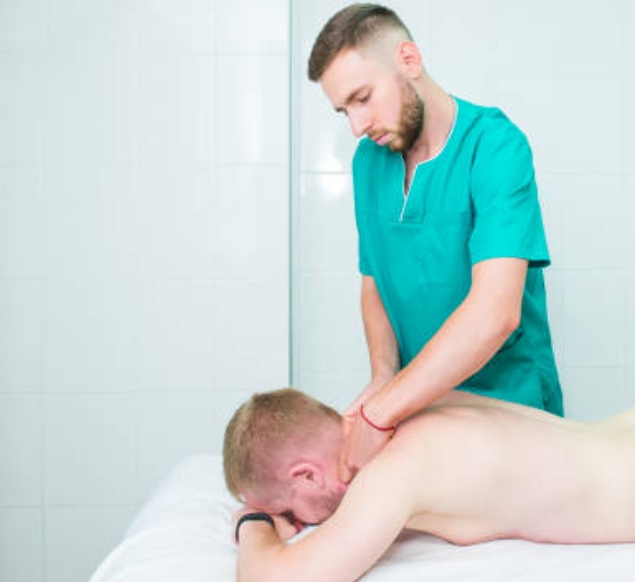Finding the best way to manipulate or mobilize the spine in patients with severe radiculopathies can be difficult for many physiotherapists.
There are two ways to determine the right direction. The first is the H-reflex approach, which Mohamed Sabahhi described (Abdulwahab and Sabbahi, 2000; Ali Ashraf and Sabbahi, 2001; Ali and Sabbahi, 2000), Another one is the Robin McKenzie-described pre-manipulative testing (McKenzie R 1981). Both are good clinical tools, but the first one is more objective and measurable.
Pre-manipulative testing presents a hurdle in a way that the choice of movement direction for mobilization and/or manipulation techniques is frequently made primarily on clinical reasoning (which in turn may lead to applying intuition when one is not careful enough) rather than an objective recording of the neurological compromise (Sabbahi et al. 2015a, 2015b). This could potentially injure the nerve roots, causing symptoms to worsen or even result in paralysis (like drop-foot or saddle anesthesia, etc.,) (Sabbahi et al. 2015b). However, White SG, et al. (2015) came to the conclusion that the patient ratings of the degree of pain elicited by physical testing are sufficiently trustworthy to be therapeutically relevant.
Procedure for pre-manipulative testing:
Pre-manipulative testing must be completed prior to applying a manipulative thrust with a high velocity and low amplitude. After positioning the spine for the intended thrust and applying light pressure in the desired direction, the patient is then asked to report any changes in their symptoms. The patient is placed back in a resting posture and questioned about the impact on symptoms after the pre-manipulative position has been emphasized and held. If the improvement persists, manipulation should be done (McKenzie R and May S 2003, 2006).
The modifications probably signify advancements (McKenzie R and May S 2003, 2006, Laslett M, 1987):
The symptom response during mobilization, which is usually applied before manipulation, determines the segmental level at which the manipulation will be carried out. Following this step, the effectiveness of the mobilization during patient-initiated movements (in the selected direction for treatment) is reassessed; if this now yields a positive response, the manipulative techniques are no longer necessary.
Before proceeding to another direction or position, pre-manipulative testing should be repeated. It is often recommended that every treatment session should only include one manipulative thrust.
Generally, the effectiveness of the additional intervention is assessed after one or most two manipulation sessions. The clinician may reassess the strategy if there hasn’t been a discernible improvement after one or two manipulation sessions. The modification of the strategy may signify:
- progression in the symptoms’ severity decrease.
-
centralization of pain.
-
total disappearance of any remaining signs of pain.
The changes that indicate a deterioration in the patient’s condition are (McKenzie R 1981, McKenzie and May 2003, 2006, Laslett M 1987):
- increasing symptom severity with time.
-
peripheralization of pain.
-
onset of additional symptoms of notable intensity without changes in the condition that motivated the patient to seek treatment.
Here are some key points to consider (Laslett M, 1987):
- Even if the patient’s subjective and objective assessments show no contraindications to manipulative techniques, the ‘repeated movements’ and ‘pre-manipulative testing’ are still necessary to determine whether mobilization or manipulative techniques are appropriate to use.
-
The ideal direction for therapeutic movement should be determined by ‘repeated movements’ and ‘pre-manipulative testing’.
-
Several mechanical spinal conditions can be treated with safe, effective spine manipulative therapy techniques if a meticulous evaluation through ‘repeated movements’ and ‘pre-manipulative testing’ are performed.
References:
- Abdulwahab, S.S., Sabbahi, M., 2000. Neck retractions, cervical root decompression, and radicular pain. J. Orthop. Sports Phys. Ther. 30 (1), 4–12.
-
Ali, A.A., Sabbahi, M.A., 2000. H-reflex changes under spinal loading and unloading conditions in normal subjects. Clin. Neurophysiol. 111 (4), 664–670. https://doi. org/10.1016/s1388-2457(99)00304-1.
-
Ali Ashraf, A., Sabbahi, M., 2001. Test-retest reliability of the soleus h-reflex in three different positions. Electromyo. Clin. Neur. 41 (4), 209–214 (accessed September 14, 2016).
-
Laslett M. Use of manipulative therapy for mechanical pain of spinal origin. Orthop Rev. 1987 Aug;16(8):573-81. PMID: 2969498.
-
McKenzie, R. (1981). The Lumbar Spine. First. Wellington: Spinal Publication.
-
McKenzie R, May S. The lumbar spine: mechanical diagnosis and therapy. 2nd ed. Waikanae: Spinal Publication Ltd; 2003.
-
McKenzie R, May S. The cervical and thoracic spine: mechanical diagnosis and therapy. 2nd ed. Waikanae: Spinal Publications; 2006.
-
Sabbahi, M., Ovak-Bittar, F., Abdilahi, A., 2015a. Calculating degree of neural impingement in radiculopathy using H-reflexes in loading and unloading: evidence on how to treat. Physiotherapy 101 (Supplement 1), e1311. https://doi.org/10.1016/j.physio.2015.03.1232.
-
Sabbahi M., Ovak-Bittar, F., Abdilahi, A., 2015b. Low back pain: manipulate and mobilize in the right direction based on EMG studies. Physiotherapy 101 (Supplement 1), e1311–e1312. https://doi.org/10.1016/j.physio.2015.03.1233.
-
White SG, McNair P, Laslett M, Hing W. Do patients undergoing physical testing report pain intensity reliably? Arthritis Care Res (Hoboken). 2015 May;67(6):873-9. doi: 10.1002/acr.22530. PMID: 25469821.
